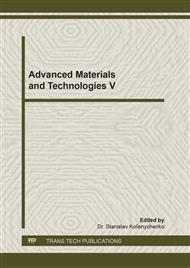[1]
ABREU, P. L., MARTINEZ, J.A., Gás Natural: O combustível do novo milênio, 2 ed., Porto Alegre, Plural Comunicação, (2003).
Google Scholar
[2]
ANANTA, G., AMARNATH, N., NAMBOODHIRI, T. K. G., Effect of heat treatments on the hydrogen embrittlement susceptibility of API X-65 grade line-pipe steel,. Bulletin of Materials Science, v. 26, n. 4, p.435–439, (2003).
DOI: 10.1007/bf02711189
Google Scholar
[3]
PEREZ, T., Corrosion in the Oil and Gas Industry. An Increasing Challenge for Materials,. The journal of the Minerals, Metals & Materials Society, v. 65, n. 8, pp.1033-1042, (2013).
DOI: 10.1007/s11837-013-0675-3
Google Scholar
[4]
BENASSI, G., Critical analysis of hydrogen permeation techniques. Application to different steel microstructures, Dissertação de M.Sc., Instituto Politécnico de Milano, Italia, (2013).
Google Scholar
[5]
LIANG, P., LI, X., DU, C., CHEN, X., Stress corrosion cracking of X80 pipeline steel in simulated alkaline soil solution,. Materials and Design, v. 30, n. 5, p.1712–1717, (2009).
DOI: 10.1016/j.matdes.2008.07.012
Google Scholar
[6]
FORERO, A. B., PONCIANO, J. A C., BOTT, I. S., Susceptibility of pipeline girth welds to hydrogen embrittlement and sulphide stress cracking,. Materials and Corrosion, v. 65, n. 5, p.531–541, (2014).
DOI: 10.1002/maco.201206574
Google Scholar
[7]
AMERICAN PETROLEUM INSTITUTE. API 5L: Specification for line pipe steel. 44 ed. Washington: API, (2007).
Google Scholar
[8]
COMPANHIA SIDERÚRGICA NACIONAL, Certificado de matéria prima do aço API 5L X52. Documento emitido em Setembro de (2012).
Google Scholar
[9]
ESAB, http://www.esab.com.br/br/pt/support/documentation/upload/catalogo-consumiveis-esab.pdf. Acessado em Janeiro de (2015).
Google Scholar
[10]
IMC,http://www.labsolda.ufsc.br/projetos/manuais/digitec_manual_instrucoes_5ed_(2002).pdf. Acessado em Março de (2015).
Google Scholar
[11]
IMC, http:// www.imc-soldagem.com.br/manuais/manual_sap_v40.pdf. Acessado em Março de (2015).
Google Scholar
[12]
NATIONAL ASSOCIATION OF CORROSION ENGINEERS. TM0177-MÉTODO A: Laboratory Testing of Metals for resistance to Sulfide Stress Cracking and Stress Corrosion Cracking in H2S Environments. Houston: NACE, (2005).
Google Scholar
[13]
TSUJIKAWA, S., MIYASAKA, A., UEDA, M., ANDO, S., SHIBATA, T., HARUNA, T., Alternative for Evaluating Sour Gas resistance of Low-Alloy Steels and Corrosion- Resistant Alloys,. Corrosion, v. 49, p.409–419, (1993).
DOI: 10.5006/1.3316068
Google Scholar
[14]
BALLESTEROS, A.F., Avaliação da Resistencia de Juntas Soldadas Circunferênciais de Aço API 5L X-80 à Corrosão Sob Tensão na Presença de Sulfetos e Susceptibilidade à Fragilização por Hidrogênio, Tese de D.Sc., Pontificia Universidade Católica do Rio de Janeiro, Rio de Janeiro, RJ, Brasil, (2009).
DOI: 10.17771/pucrio.acad.32706
Google Scholar
[15]
NATIONAL ASSOCIATION OF CORROSION ENGINEERS. MR0175/ISO 15156-1: Petroleum and Natural Gas Industries-Materials for use in H2S-containing Environments in Oil and Gas Production. Houston: NACE, (2001).
DOI: 10.3403/bseniso15156
Google Scholar
[16]
AMERICAN SOCIETY FOR TESTING AND MATERIALS. ASTM G129-00: Standard Practice for Slow Strain Rate Testing to Evaluate the Susceptibility of Metallic Materials to Environmentally Assisted Cracking. West Conshohocken: ASTM International, (2006).
DOI: 10.1520/g0129-95
Google Scholar
[17]
NATIONAL ASSOCIATION OF CORROSION ENGINEERS. NACE TM-0198: Slow Strain Rate Test Method for Screening Corrosion-Resistant Alloys (CRAs) for Stress Corrosion Cracking in Sour Oilfield Service. Houston: NACE, (2004).
DOI: 10.1520/stp38116s
Google Scholar
[18]
ALCÂNTARA. N.G., Efeitos do hidrogênio em juntas soldadas. Gases em metais e ligas, Rio de Janeiro, EDC, (1994).
Google Scholar


